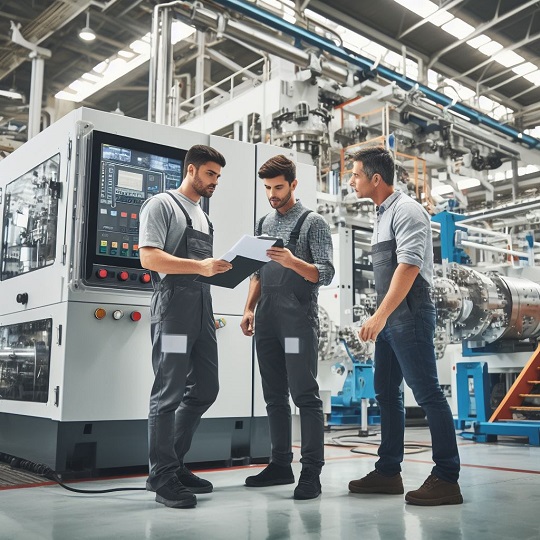In the world of manufacturing, efficiency is the name of the game. It’s the key to reducing costs, improving product quality, and staying competitive in a rapidly evolving market.
At the heart of manufacturing efficiency lies the collaboration between two critical departments: production and maintenance. When these two teams work in harmony, they can prevent costly downtime, minimize unexpected breakdowns, and ultimately optimize the entire manufacturing process.
In this blog post, we’ll delve into the ways in which production and maintenance departments can collaborate effectively to maintain and enhance the efficiency of a manufacturing operation.
Before we go further into this topic, don’t forget to follow my LinkedIn account. You’ll get more helpful insights on supply chain management there.
Table of Contents
Regular Communication
Open lines of communication are the cornerstone of a successful collaboration between production and maintenance departments.
Regular meetings and discussions create an environment where issues, concerns, and improvement opportunities can be openly shared. These are some key communication practices:
- Meetings and Huddles: Periodic meetings should be held to discuss ongoing challenges and updates. These meetings can include production supervisors, maintenance managers, and relevant team members.
- Suggestion Box: Create a platform for employees to submit suggestions or report issues anonymously. This can encourage more participation and improve communication.
- Digital Tools: Utilize digital tools and platforms for real-time communication and updates, such as shared project management software or collaboration apps like Slack.
By fostering a culture of open communication, both departments can share insights and address concerns, ultimately contributing to the overall efficiency of the manufacturing process.
Preventive Maintenance
Preventive maintenance is the proactive approach to keeping equipment and machinery in optimal working condition.

It involves scheduling routine maintenance tasks based on manufacturer recommendations and historical data. The collaboration between production and maintenance in this area is crucial:
- Scheduling: Production and maintenance should collaborate to schedule maintenance during planned downtime. This ensures that maintenance activities do not disrupt production.
- Shared Responsibility: Both departments should share the responsibility for equipment care and performance. Production can assist by reporting any early warning signs of equipment issues.
- Checklists and Records: Maintain detailed checklists and records for preventive maintenance tasks. Ensure that production staff and maintenance personnel have access to these records.
By coordinating efforts in preventive maintenance, production can rely on equipment that functions optimally, reducing unplanned downtime and disruptions.
Data Sharing
Data is a valuable asset in manufacturing. Both production and maintenance can benefit from sharing and analyzing data and key performance indicators (KPIs) to enhance efficiency:
- Tracking Machine Performance: Both departments can collaborate to track machine performance and identify patterns of breakdowns. This information can help maintenance prioritize maintenance tasks.
- Feedback Loop: Production staff can provide valuable feedback on equipment performance and any unusual behavior observed during production. This information can assist maintenance in diagnosing issues more effectively.
- Data-Driven Decision-Making: Encourage both departments to use data for decision-making. This can include predicting maintenance needs, optimizing production schedules, and identifying areas for improvement.
Collaboration in data analysis allows for more informed decisions, reducing costly downtime and improving overall efficiency.
You might also like:
Cross-Training
Cross-training is an approach that encourages employees to gain a basic understanding of tasks outside their primary roles.
In manufacturing, cross-training can be highly beneficial for both production and maintenance teams:
- Basic Maintenance Knowledge: Production personnel can benefit from basic maintenance training to understand equipment functions and identify potential issues.
- Safety Training: Cross-training can also encompass safety protocols. Both departments should have a solid understanding of safety measures to protect employees and equipment.
- Shared Knowledge: Cross-training fosters a culture of shared knowledge and responsibility. Employees can appreciate the challenges and requirements of each department, leading to more effective collaboration.
When employees from both departments are equipped with a broader skill set, they can work more harmoniously and contribute to the smooth operation of the manufacturing process.
Standard Operating Procedures (SOPs)
Well-documented and consistently followed standard operating procedures (SOPs) are essential for maintaining efficiency in manufacturing.

Collaboration between production and maintenance in this area ensures that everyone is on the same page:
- Develop Clear SOPs: Create and maintain clear, detailed SOPs for both production and maintenance tasks. These procedures should be easily accessible to all employees.
- Training and Compliance: Ensure that employees in both departments are not only familiar with the SOPs but also compliant with them. Regular training and audits can help achieve this goal.
- Continuous Improvement: Encourage a culture of continuous improvement in SOPs. If a better way to perform a task is identified, it should be incorporated into the procedures.
Standard operating procedures provide a framework for consistent and efficient work practices, reducing errors and disruptions.
Root Cause Analysis
When equipment breakdowns occur, identifying and addressing the root causes is critical for preventing future incidents. The collaboration between production and maintenance in root cause analysis can be a game-changer:
- Problem-Solving Teams: Create cross-functional teams that include members from both production and maintenance departments to conduct root cause analyses.
- The “5 Whys” Technique: Utilize tools like the “5 Whys” technique to delve deeper into the reasons behind problems. By asking a series of “why” questions, teams can uncover underlying issues.
- Corrective Actions: Once the root cause is identified, both departments should work together to implement corrective actions. This may involve process changes, equipment upgrades, or revised maintenance procedures.
Collaborative root cause analysis is instrumental in preventing recurring issues and enhancing the overall reliability of manufacturing processes.
Spare Parts Inventory
A well-organized and well-stocked spare parts inventory is vital for maintaining the efficiency of a manufacturing operation. Both production and maintenance should collaborate on this aspect:
- Inventory Management: Develop and maintain a comprehensive spare parts inventory with input from both departments. It should include critical spare parts and consumables.
- Coordination: Production should provide insights into which components are most critical for their processes. This can help maintenance teams prioritize which parts to keep in stock.
- Emergency Response: In the event of unexpected breakdowns, having an efficiently managed spare parts inventory can significantly reduce equipment downtime.
A well-coordinated spare parts inventory ensures that maintenance teams have quick access to the necessary components, minimizing costly downtime.
Continuous Improvement
Continuous improvement is a philosophy that should be embedded in the culture of both production and maintenance departments. Here’s how collaboration can drive this principle:
- Innovation and Creativity: Foster innovation and creativity within both departments. Encourage employees to propose and implement better maintenance and production practices.
- Regular Process Reviews: Both departments should regularly review their processes to identify opportunities for enhancement. This can include technology upgrades and the adoption of best practices.
- Benchmarking and Industry Research: Stay updated on industry trends and benchmark against other organizations to identify areas where improvements can be made.
A commitment to continuous improvement ensures that manufacturing processes remain efficient, adaptable, and competitive.
You might also like:
- 33 Strategies How to Significantly Reducing Supply Chain Lead Times
- How Challenging Should Supply Chain KPI Targets be Set?
Safety
Safety is a non-negotiable aspect of manufacturing, and both production and maintenance departments must work collaboratively to ensure the well-being of employees and equipment:
- Safety Protocols: Collaborate on safety protocols and procedures to guarantee that employees in both departments are aware of and follow safety measures.
- Safety Audits: Conduct regular safety audits to identify potential risks and areas for improvement. These audits should involve members from both departments.
- Safety Training: Invest in ongoing safety training for employees. This can include training on the safe operation of equipment and machinery.
By maintaining a strong focus on safety, manufacturing facilities can reduce accidents, injuries, and equipment damage, which can disrupt production and erode efficiency.
Training and Development
Investing in the training and development of employees in both production and maintenance departments is essential to keep them up to date with the latest technologies and industry best practices:
- Technical Training: Ensure that maintenance personnel are well-versed in the latest maintenance techniques and technologies, while production staff stays updated on process improvements.
- Cross-Training: Encourage cross-training as previously mentioned to expand employees’ skill sets and understanding of different roles within the manufacturing process.
- Certifications and Courses: Support employees in obtaining relevant certifications and attending industry-specific courses to stay current with advancements in the field.
Training and development not only enhance the individual skills of employees but also contribute to the overall efficiency and competitiveness of the manufacturing operation.
Conclusion
In the complex world of manufacturing, the collaboration between production and maintenance departments is an essential driver of efficiency.
By implementing the strategies outlined in this blog post, companies can reduce downtime, minimize unexpected breakdowns, and ensure that their manufacturing processes run like well-oiled machines.
Regular communication, preventive maintenance, data sharing, cross-training, standard operating procedures, root cause analysis, efficient spare parts management, continuous improvement, safety, and ongoing training and development are all vital components of this collaboration.
When these two departments work together seamlessly, the result is a leaner, more productive, and cost-effective manufacturing operation that can thrive in today’s competitive landscape.
Efficiency is the lifeblood of manufacturing, and the synergy between production and maintenance is the beating heart that sustains it.
By prioritizing collaboration and following the best practices outlined here, manufacturers can maintain and enhance their competitive edge in a rapidly evolving industry.
I hope you find it helpful!
Please share this article with your colleagues so they can also benefit. For more insights on supply chain management, follow my LinkedIn account. You’re free to use all articles on this blog for any purpose, even for commercial use, without needing to give credit.

 by
by 

